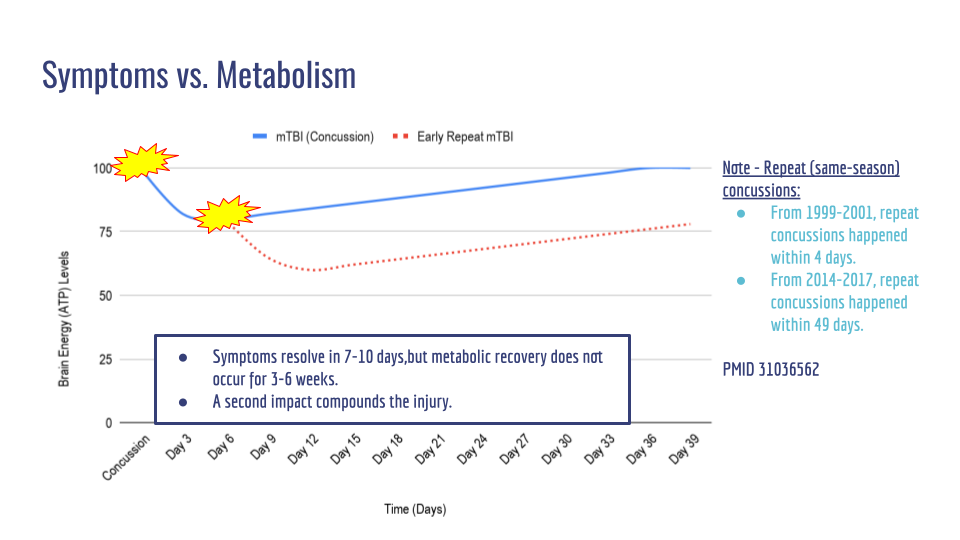The Dangers of a Seven-Day Return to Play After a Concussion
If your athlete suffers a concussion on a Friday and is cleared to play the following Friday, that’s not just a mistake—it’s a dangerous oversight. I’m Dr. Mark, a concussion specialist, and today, we’re diving deep into why the seven-day return-to-play (RTP) protocol is outdated and how it puts athletes at significant risk.
Table of Contents
Why Seven Days is Too Soon
The Science of Brain Metabolism Post-Concussion
The Risks of Premature Return to Play
Research and International Recommendations
Takeaway: Prioritize Brain Health
Why Seven Days is Too Soon
While professional sports organizations are beginning to recognize the dangers of rushing concussion recovery, the outdated seven-day RTP protocol persists in many levels of competition. A stark example is the case of NFL quarterback Tua Tagovailoa, who sustained two concussions within four days, highlighting the critical flaws in current concussion management protocols. His case serves as a real-world illustration of why adherence to scientific evidence is crucial for protecting athletes from potentially life-threatening outcomes.
The Science of Brain Metabolism Post-Concussion
At the core of concussion recovery is brain metabolism—the process by which the brain produces and utilizes energy. After a concussion, the brain enters an energy crisis due to impaired glucose metabolism and disrupted cellular function. Here’s how this unfolds:
The “neurometabolic cascade” of concussion/mTBI & the subsequent energy deficit and metabolic recovery.
Day 0 (Injury Occurs): The brain is functioning at 100% energy demand.
Days 1-3: A significant energy deficit occurs, with ATP (energy) production dropping by approximately 20-30%. Symptoms often peak around this time.
Days 5-10: While symptoms may subside, the brain’s metabolic recovery is incomplete, making it more vulnerable to further trauma.
Days 21-30: Research shows that full metabolic recovery generally occurs within three to four weeks post-injury.
This means that even if an athlete “feels fine” at day seven, their brain is still operating at a deficit and remains highly susceptible to reinjury.
The proposed metabolic insult of a repeat concussion (mTBI).
The Risks of Premature Return to Play
1. Second Impact Syndrome (SIS)
Returning to play before metabolic recovery significantly increases the risk of Second Impact Syndrome (SIS)—a rare but often fatal condition where a second concussion occurs before the first has healed. This can cause rapid brain swelling, leading to severe neurological damage or death. This risk is only presumed to be present during the acute (0-72hrs) stages following a concussion (e.g., returning to play in the same game or the next day).
2. Persistent Post-Concussion Symptoms (PPCS)
Early return to play increases the likelihood of developing Persistent Post-Concussion Symptoms (PPCS), where symptoms such as headaches, dizziness, and cognitive impairments last beyond 30 days. Research from a 2022 JAMA study found that 56% of athletes who did not receive structured rehabilitation still had symptoms six months after injury.
3. Cognitive and Motor Impairments
Even after initial symptoms fade, functional MRI studies show altered brain activity weeks after a concussion. Athletes who return too soon often experience slower reaction times, poor decision-making, and reduced coordination, all of which increase the likelihood of additional injuries.
Research and International Recommendations
1. The 21-Day Minimum
Several studies support a minimum of 21 days before RTP. For example:
A 2023 study published in Arthroscopy: The Journal of Arthroscopic & Related Surgery by Wait et al. found that the median time to return to sports after concussion is within 21 days in 80% of published studies.
In Australia, national RTP guidelines mandate a 21-day minimum before an athlete can be cleared for competition.
2. The Consensus Statement on Concussion in Sport
The Berlin Consensus Statement (2017)—an internationally recognized guideline—emphasizes that RTP should be gradual and symptom-limited, with an individualized approach rather than a fixed timeline.
Takeaway: Prioritize Brain Health
We must treat concussions with the same level of seriousness as orthopedic injuries. If an athlete suffered a ligament tear, no doctor would recommend returning to play within seven days—so why is this still happening with brain injuries?
Key Recommendations:
Parents & Coaches: Advocate for longer recovery times and evidence-based protocols.
Athletes: Even if you feel symptom-free, wait at least 21 days and follow a structured return-to-play protocol.
Healthcare Providers: Use metabolic recovery markers, not just symptom resolution, to determine RTP readiness.
Final Thoughts
If your athlete has suffered a concussion, prioritize their long-term brain health over short-term performance.
The seven-day RTP protocol is outdated and dangerous. Instead, implement a minimum of 21 days before considering a return to play.
Let’s work together to make sports safer for athletes at all levels!

